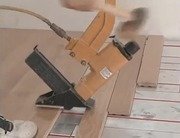Engineered Wood Floor Joist System
Bob discusses the advantages of engineered wood flooring with Steve Barth (from Willamette Industries).
Clip Summary
Bob discusses the advantages of engineered wood flooring with Steve Barth (from Willamette Industries) at the house in Mt. Pleasant, near Charleston, South Carolina.Bob Vila: All right. I'm going to let you guys put these in place while I say "Hi" to Steve Barth from Willamette Industries. Hey, Steve. Steve Barth: Hello, Bob. Bob: Now this is the E‑Z Frame System that we're putting together here for the first floor deck structure. Steve: That's right. Bob: What does it consist of? Steve: The E‑Z Frame System is a fully integrated, engineered wood framing package. Bob: Right. Normally in house construction when you're putting a girt up, which is normally a large timber that breaks up the span, you use a big old timber. This is a glulam. Steve: This is our premiere plus glulam. It's an I‑Joist compatible laminated beam. It's made to match the depths of the engineered wood. We use a high strength lumber in the top and the bottom, lower strength in the middle. We've taken and created a piece of lumber that's much stronger than its dimensional solid‑sawn counterparts. Bob: This sits on a traditional sill which is pressure treated. Steve: Pressure treated. Bob: Then what are the other components involved in the E‑Z Frame? Steve: The second component would be our StrucJoist, I‑Joist, which is, as we start feeding these to these guys, this is our I‑Joist. We take in our high strength, StrucLam, laminated veneer lumber. We use that for our flange. Bob: This is all laminated veneer. Steve: Exactly, top and bottom. Then we use our OSB web material for the web of the joist. Bob: Oriented strand board. Steve: Oriented strand board. Bob: Of course, this member here would be referred to as a web. Steve: Correct. Bob: Why don't you just pass them on up inside here and I'll lay them out for the guys. Now the strength of this, one of the key things with this system is that you're never going to have to worry much about squeaky floors. Steve: Exactly. Since it's pre‑engineered it's going to be much straighter, stronger, and more consistent than the dimension lumber counterparts. It's not going to cause defects, humps, and dips in your floors like you would have with conventional lumber. Bob: What about the outer edge? We're looking at OSB there again, right? Steve: Exactly. To finish out the system we use our rim board plus, E‑Z Rim, finishes the enclosure for the joist system. It completely goes around the perimeter of the structure. It provides vertical and lateral support. High wind loads, seismic loads, and load transfer from the roof all the way to the foundation. Bob: It's interesting how the industry has been affected by all the natural disasters that we've had to deal with in the last 20 years, hurricanes here in the Carolinas and Florida, earthquakes out in California. These are the types of systems that solve some of those problems. Steve, what are the advantages of using the E‑Z Frame System over conventional stick framing? Steve: Engineered wood is going to be stiffer, stronger. It spans farther distances because it's an engineered product. It's lightweight. As you can see it's very easy to maneuver around and manipulate versus it's counterpart in dimensional lumber, which is much heavier. Since it's consistent, it's straight. Bob: What about the cost of the E‑Z Frame System compared to traditional stick building? Steve: Bob, fit for fit if you do a comparison the E‑Z Frame System might look a little expensive. When you look at the whole there's a lot of places that we can take economies or span farther distances, eliminate structure that would be required for conventional lumber. Quite often the system as a whole is going to be slightly more to even slightly less than the conventional floor system. Bob: To your comment about stability and regularity, if you look along the tops of all these I‑Joists it really looks to the horizon really flat and even. Steve: That's right. It really shows the consistency and uniformity of the engineered wood products. Bob: Listen, thanks for coming out. Riley, you ready to hang a joist... Riley: Yeah, we're all set. Bob: ...joist hanger over here? I understand you got a new gadget here to show us. Riley: Yeah, I've got a palm nailer. Bob: It's a pneumatic nailer... Riley: A pneumatic nailer, right. Bob: ...that will allow us to get the joist hangers in place quickly. How come we're putting in that filler there? Riley: This is going to stiffen this web, so it's not rocking in here. Bob: The other part of the story is very often when you have these engineered systems you don't get the exact joist hangers that you require. Bob: What we're doing here is a slight fix that is approved by the Willamette folks. Bob: It stiffens it up and lets you use this type of joist hanger. Riley: You get it on that side Russ? Russ: Sure did. Riley: This is a great tool. It fits in your hand nice and easy. You get into all these tight spots. Bob: OK, here comes the last one. This one doesn't need a joist hanger because it sits right on top of the sill. Riley: Sits right up here. Bob: Then the final component is the rim. Here you go Kelly. Kelly: Thanks, Bob. Riley: You like it?






